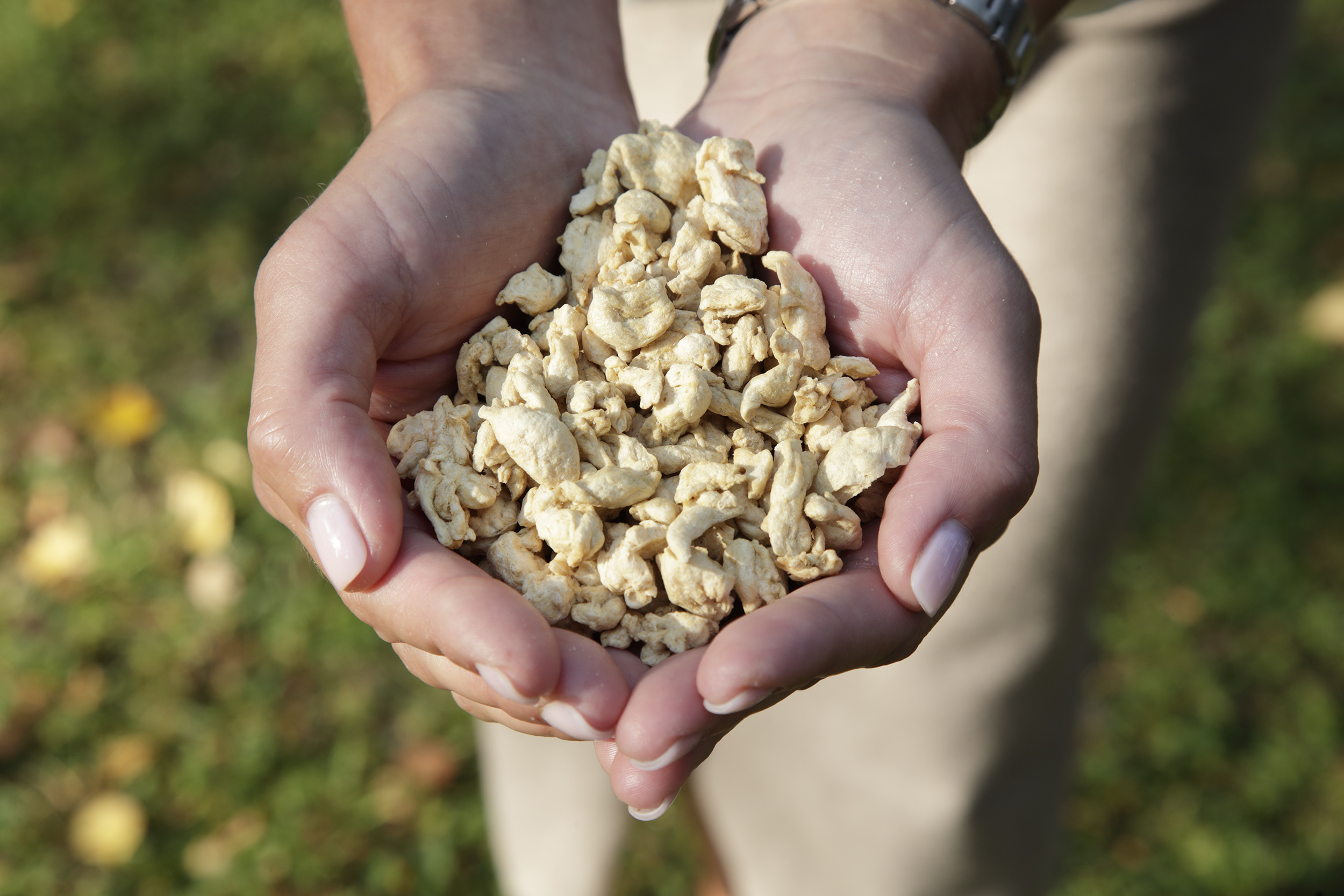

Deep Dive: Form Follows Function
Louise Davis meets the food-tech specialists who are working to advance the fortification and functionality of plant-based proteins in a bid to meet rising consumer demands for better nutrition and versatility
Summarizing the state of plant-based protein production, Sumit Pingle, Vice President of Agro & Protein Systems at Alfa Laval, says, “The key to market success lies in a food producer’s ability to offer either affordable alternatives that closely resemble familiar foods or entirely new experiences – though the latter comes with greater market adoption challenges.”

Pingle also notes that whether a product mimics traditional foods or introduces something novel, many consumers will try an alternative once out of curiosity, but “success is represented by repeat sales”.
According to Pingle, there is still much that can be done by food companies to attract that repeat business. “By improving the understanding of the functional properties (such as gelling, emulsification, solubility, etc) of various plant-derived proteins, food producers can formulate better consumer products. For example, solubility is a crucial property for formulating new beverages, while gelling is important for meat analogs,” he details.
So, how are processing technology experts such as Alfa Laval enabling some of these advances in protein functionality? “Processing has a certain effect on the functionality, but it is still mostly impacted by the type of plant/crop from which it was extracted from – e.g. soy, yellow pea, sunflower seed, etc,” answers Pingle. “However, there are steps in the processing design where the product needs to be heated for pasteurization and drying. It is crucial that these operations are designed such that the heat damage to the protein is minimized and the functionality retained.” He also notes that another aspect of investigation is to minimize the acidic and basic conditions that the proteins are subjected to, “as these can have an effect on the functionality, especially after long exposure”.
Detailing Alfa Laval’s own approach, Pingle notes, “We are always testing various feedstocks to optimize our thermal and separation equipment as well as design our processes to ensure maximum protein recovery and minimal utility consumption. Sharing our knowledge to food producers enables quicker and confident decisions during process design.”
The company’s development work in processing technology is targeted toward improving ingredient functionality but also reducing the process carbon footprint and cost of processing. And, Pingle comments, “We have been successful in applying experiences from other industries to plant-based proteins processing. The TopStream separation technology is an excellent example; it provides improved product yields of proteins at lower investment costs.”
Satisfaction guaranteed
Kesha Stickland is another plant proteins expert who is applying learnings from other industries to plant-based foods, but interestingly, the Co-Founder & CEO of The Mushroom Meat Co. is applying business methodologies as well as technologies. “We use a systems principle known as ‘The Theory of Constraints’ to manage the tension between consumer desires for simple ingredients with the functional requirements of delivering products with great taste and texture,” explains the entrepreneur. “This means that we always select ingredients and methods by a process of elimination. We set constraints such as: whole foods instead of isolates; avoiding the use of chemically and genetically modified ingredients; and using herbs and spices instead of so-called ‘natural flavors’”.

To prevent her products from becoming ultra-processed foods (UPFs), Stickland follows a design approach she calls ‘Biomimicry 2.0.’ “I invented this method, and we apply it to all our products,“ she explains.
The first principle is selecting whole foods with desirable traits – such as striated texture, umami richness, and natural binding properties. The second is enhancing nature through natural processes, combining traditional methods such as proprietary fermentation and mechanical manipulation (e.g., shredding, chopping, grinding) to refine food properties. Applying those techniques has enabled Stickland to develop a set of base ingredients that are now used to create a variety of beef and pork analogs. “They’re made with mushrooms and whole plants, but they feature the properties of meat via rich, animalic flavors, dense meaty textures, and the same cooking properties,” she details.
Although Stickland believes that better functionality is key to increasing consumer adoption, functionality is not her main priority. “We believe this minimally processed, whole-food approach to creating meat analogs is the future of alt protein. It’s what consumers and food-service operators are looking for. We carefully select ingredients both for their built-in functional properties and nutrition.”
Describing her overall ethos, Stickland notes, “We’re not alternative protein: we’re alternative nutrition. The concept of fortification is counter to our belief system. Whole foods come with all their fiber, protein, vitamins and minerals intact, so there’s no need for fortification. Ingredients such as functional mushrooms, hemp seeds, beets and seaweed give our products a nutritional profile that is hard to beat.”
Fortified defenses
MJ Kinney, the Principal Food Scientist & Founder of the highly regarded food consultancy, FareScience, explains that fortification does play a key role in some applications. “This isn’t a new trend: I’ve always known plant-based proteins to have a focus on fortification – in fact, I would argue it’s been the primary value driver,” she begins. “Health trends have supported increased protein content for years, which translates to an opportunity for producers to introduce protein content where there traditionally isn’t any, or to an extent that competes with or exceeds offerings within its category. Plant proteins are widely used to fortify a product to deliver extra protein content.”

Clarifying how fortification is usually deployed, Kinney says, “The practice of fortifying – as seen with vitamins and minerals – is actually common in end products, but that doesn’t mean the plant protein ingredient itself (e.g. soy, pea, chickpea) is fortified by the ingredient manufacturer (e.g. Roquette) before sale to a B2C (e.g. Beyond Meat) company.
“What a branded food company will need to know upfront is how they want protein to be mentioned on their product’s packaging and throughout that product’s marketing,” Kinney continues. “This brings into the fold nutrient level claims, which identify the amount needed per nutrient to use a variety of terms (such as ‘good’ or ‘excellent source of’). For example, to use ‘good source of protein’ on a product, it needs to have at least 10% of the Daily Reference Value (DRV) for protein per serving to be compliant. The DRV for protein is 50g, which means a product needs at least 5g of protein per serving to make this claim.”
And this is where it gets tricky, according to Kinney. “Plant proteins are generally not considered a complete protein source. This ultimately means they don’t have the array or quantity of amino acids required to yield a Protein Digestibility Corrected Amino Acid Score (PDCAAS) of 1.0 – unlike many (not all) animal-derived protein sources. Soy protein isolate is an exception, and theoretically, advanced seed genetics and processing could get other plant proteins to this ‘complete’ standard.
“In the meantime, food product developers fortifying with plant proteins must consider the protein quality (PDCAAS) in addition to the protein content to calculate the true amount of a specific protein to be added to reach compliance with nutrient level claims.”
The calculation process that layers protein quality on top of protein content is often referred to as ‘PDCAAS-corrected’, Kinney says. “In this example, when fortification is done correctly, a formulator will yield a product with at least 5g of complete protein per serving. This will yield a value of 5g or higher under protein content and report a minimum percentage daily value of 10% – a field that is otherwise optional to report.”
Kinney says that one solution has been the combination of two or more plant proteins, generally pre-blended in specific ratios by a manufacturer, to yield a PDCAAS of 1.0 (e.g. combining pea with rice protein). “However, in the US market, the most versatile option is to understand the details outlined in the Code of Federal Regulations to give a company free rein to decide which plant protein sources, from which suppliers/manufacturers, and in what amounts are needed to get it not only to compliance, but also to produce a plant-based product designed effectively for integrity and cost purposes.”
When prompted for examples of high-quality products that have achieved commercial success here, Kinney struggles to put a positive spin on the situation thus far. “Sadly, the conversation around plant-specific protein quality and its connection to nutrient level claims has proven so complicated that companies will often deprioritize it, find alternative language to satisfy the needs of marketing and legal, or worse, produce and market products without being in compliance,” she states.

However, she does proffer one interesting example. “The sports nutrition category – what is often found in a grocery’s pharmacy section – generally upholds the implementation of plant proteins to an extent that has a complete protein profile (PDCAAS of 1.0), and further, that is mostly absorbed by the human body,” Kinney explains.
“With the prevalence of plant protein ingredients being sold individually/standalone, as well as the mass creation of products by non-experts, there is a real gap in high-integrity, plant-based products – at least in terms of compliance, and further, in either sustaining the requirements of human nutrition or being of nutritional mimicry to the animal-derived protein source. Over time, I would assume even the premium sports nutrition brands will ditch the complete protein standard (for their plant-based offerings) to better compete on price with the products in their market category that have never prioritized it.”
The flying Finn
Jari Karlsson, CEO & Co-Founder of Finnish startup Happy Plant Protein, believes it is not the food producers who will ultimately determine the pace and scale of the plant-based transition – it’s the consumers. “The entire food industry must understand this,” he emphasizes. “Taste, price, and attributes such as health, clean-label and sustainability, all need to be aligned. I would add to that list localization, which is one of the strengths of our process.
“Happy Plant Protein’s patented approach uses existing extruders already in use in the food industry,” Karlsson adds. “This allows us to process local raw materials, such as legumes, into plant protein for local food production, providing consumers with truly local food solutions.”
Karlsson feels that when it comes to improving functionality and fortification to help plant proteins become a viable long-term alternative to animal-derived proteins, the key is not to make plant proteins an alternative, but rather to recognize that they are equally important and valuable sources of protein compared with animal-based sources.
“If we set aside the narrative of saving the planet and sustainability for a moment, the basic attributes have to be right for consumers to embrace them – taste, texture,
and ease of use in various food applications. Of course, nutrition is essential, and plant-based foods often have a natural advantage in terms of health benefits,” he states.

Karlsson points out that functionality is obviously critical in food. “Different types of foods require their own specific functional ingredients,” he says. “After all, traditional meat, dairy, or bakery products don’t use the same ingredients across the line. Similarly, plant-based alternatives need tailored ingredients. Although protein is protein, fat is fat, and carbohydrates are carbohydrates, the basic properties of these ingredients still need to meet the functional requirements of the application.”
How is Happy Plant Protein enabling some of these advances? “The ingredients created by our process are not generic, like protein isolates that are often widely used in different food products,” Karlsson explains. “Instead, we optimize our ingredients for specific food applications. For example, our textured vegetable protein-type ingredient is fine-tuned for structure, taste, texture and bite, making it ideal for meat alternatives. It is also rich in fiber and minerals. Our carbohydrate ingredient – which also contains small amounts of protein and fiber – offers excellent functionality for non-dairy and bakery products due to its unique properties.”
Describing his single-step process that uses existing food industry equipment, Karlsson is almost making it sound easy to tackle the challenges thrown up by the need to improve functionality. Surely, there must be some technical hurdles remaining? “Our technology is versatile in processing various raw materials such as peas, fava beans, lentils, chickpeas, and oats,” he says. “We’ve refined the ingredient properties to meet the needs of consumers and the food industry, making our technology genuinely cost-efficient, sustainable, and effective for producing local plant-based proteins. At least with our technology, I think there are no hurdles.”

Supply and demand
Similar to Karlsson, Jaclyn Simons, Business Development Manager New Food in North America at GEA, also believes that consumers are driving the demand for technical advances in plant-based proteins. “They are looking for products that not only taste good but also offer the same nutritional value as animal proteins,” she says. “Fortifying plant-based products with essential nutrients such as vitamin B, calcium, and iron helps bridge this gap, making them a more realistic alternative. Improved functionality – such as better solubility, texture, and stability – also plays a key role in helping plant proteins replace animal-derived ingredients in everyday foods.”
Simons explains that it’s GEA’s customers – the ingredient producers – who are the real experts in developing these products. “We support their innovations by providing processing expertise and advanced technology,” she details. “In our technical centers, we test a wide range of ingredients with our high-shear mixers, drying systems, and separation technologies to optimize protein functionality and processing efficiency. This helps manufacturers develop high-quality, next-generation alternative proteins at scale.”
Discussing improved functional properties, Simons notes that, “For plant proteins to be widely used, they need to behave like animal proteins in food applications. Gelling properties help create the firm texture needed for plant-based burgers and sausages. Emulsification is key to smooth and creamy dairy alternatives such as yogurt and cream cheese. Improved solubility expands their use in protein-enriched beverages and bakery products. These advancements make plant proteins more versatile, allowing them to replace traditional ingredients in a wider range of foods.”
And, she adds, GEA’s processing solutions help unlock these properties. “Our advanced drying systems, for example, improve agglomeration, making plant proteins more soluble. Our high-shear mixers and UHT systems enhance processing for plant-based beverages, ensuring better stability and texture. By fine-tuning these processes, we help ingredient producers create functional plant proteins that meet both consumer and industry expectations.”

A key focus area for GEA is precision fermentation, and Simons describes the firm’s work here as “helping precision fermentation open up new possibilities for plant-based proteins”. Expanding on that, she adds, “Precision fermentation has already transformed dairy alternatives such as whey and casein, and it is now improving the taste, texture, and functionality of plant proteins. This technology produces high-purity, targeted proteins with better solubility, emulsification, and gelling properties, making them more effective in meat, dairy, and bakery applications.”
But, Simons notes, the potential goes beyond animal proteins. “Cocoa-free chocolate and bean-free coffee are now emerging through precision fermentation, reducing dependence on resource-intensive crops. Sweet proteins from plants and fungi – such as brazzein, monellin, thaumatin, and mycodulcein – offer sugar alternatives that are significantly sweeter than sugar, helping manufacturers reduce sugar content without losing taste. Companies are commercializing brazzein, while others are exploring truffle-derived sweet proteins. We support these advancements with our Axenic M (for microbial processing) and Axenic P (for pilot processes) bioreactor systems, combined with advanced downstream processing for harvesting, filtration, and drying. These technologies help ingredient producers scale precision fermentation efficiently and sustainably, paving the way for a new generation of alternative food ingredients.”
Indeed, it’s that integration of processing technologies with the modern breed of ingredients that is helping to address functionality challenges in a variety of ways. “Several factors influence the functionality and cost of precision-fermented plant proteins,” Simons says. “The cell line must be optimized to produce the target protein efficiently – otherwise, the final product won’t perform as expected. Culture media formulation also plays a major role, both in terms of yield and cost, making it a key focus area for optimization.
“The production environment is equally critical,” she continues. “Small variations in temperature, pH, and process conditions can significantly affect protein quality. Bioprocess control ensures consistent results, preventing batch-to-batch variations. After fermentation, downstream processing – including protein extraction, separation, filtration, and drying – is essential for obtaining high-purity, functional proteins that meet industry standards.”
Commenting on the array of solutions that GEA offers to help manufacturers tackle these challenges, Simons says, “By fine-tuning each stage – from fermentation to final processing – we help ingredient producers scale plant-based proteins efficiently, improving both functionality and commercial viability.”
If you have any questions or would like to get in touch with us, please email info@futureofproteinproduction.com







